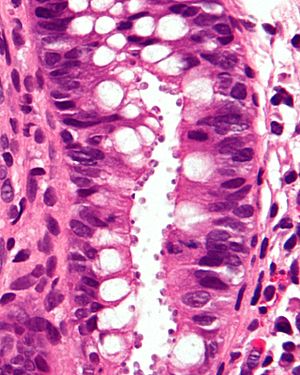Cryptosporidiosis
| Bệnh do Cryptosporidium Cryptosporidiosis | |
|---|---|
 | |
| Hiển vi cho thấy cryptosporidiosis. Cryptosporidium là các cơ quan tròn nhỏ trong không bào ở đỉnh sinh trưởng trên bề mặt tế bào biểu mô. Biến màu H&E. Sinh thiết ruột kết. | |
| Chuyên khoa | bệnh truyền nhiễm |
| ICD-10 | A07.2 |
| ICD-9-CM | 007.4 |
| DiseasesDB | 3221 |
| MedlinePlus | 000617 |
| eMedicine | med/484 |
| Patient UK | Cryptosporidiosis |
Cryptosporidiosis, cũng được gọi là crypto,[1] là một bệnh ký sinh gây ra bởi Cryptosporidium, một loại ký sinh trùng đơn bào thuộc ngành Apicomplexa. Ảnh hưởng đến đường ruột và có thể ảnh hưởng đến hệ hô hấp trên cả hệ miễn dịch và suy giảm miễn dịch cá thể, dẫn đến tiêu chảy (crypto tiêu hóa) có thể có hoặc không có chứng ho dai dẳng (crypto hô hấp).[2] Trong cá thể suy giảm miễn dịch, triệu chứng này đặc biệt nghiêm trọng và thường gây tử vong. Chủ yếu lây lan qua đường phân-miệng, thường thông qua nước bị ô nhiễm;[1][2] bằng chứng gần đây cho thấy rằng nó cũng có thể được truyền qua đồ vật truyền bệnh theo đường bài tiết hô hấp.[2]
Tham khảo[sửa | sửa mã nguồn]
- ^ a b “Cryptosporidiosis”. Centers for Disease Control and Prevention. ngày 5 tháng 2 năm 2009.
- ^ a b c Sponseller JK, Griffiths JK, Tzipori S (2014). “The evolution of respiratory Cryptosporidiosis: evidence for transmission by inhalation”. Clin. Microbiol. Rev. 27 (3): 575–86. doi:10.1128/CMR.00115-13. PMC 4135895. PMID 24982322.
Recent evidence indicates that respiratory cryptosporidiosis may occur commonly in immunocompetent children with cryptosporidial diarrhea and unexplained cough. Findings from animal models, human case reports, and a few epidemiological studies suggest that Cryptosporidium may be transmitted via respiratory secretions, in addition to the more recognized fecal-oral route. ... Upper respiratory cryptosporidiosis may cause inflammation of the nasal mucosa, sinuses, larynx, and trachea, accompanied by nasal discharge and voice change (54, 61, 62). Cryptosporidiosis of the lower respiratory tract typically results in productive cough, dyspnea, fever, and hypoxemia (63,–66). ... While fecal-oral transmission is indisputably the major route of infection, transmission via coughing and fomites is also possible in situations of close contact (20). ... Because they lacked gastrointestinal symptoms and oocyst excretion, the latter cases establish the possibility of primary respiratory infection with Cryptosporidium, which may have been acquired by inhalation of expectorated droplets or by contact with fomites. ... This finding suggests that respiratory cryptosporidiosis may occur commonly in immunocompetent individuals.
Liên kết ngoài[sửa | sửa mã nguồn]
- Cryptosporidiosis — Centers for Disease Control and Prevention
- Aquatics International Article Regarding Infection via Spray Parks Lưu trữ 2011-07-07 tại Wayback Machine
- Monroe County Health Dept. Fact Sheet Lưu trữ 2006-03-07 tại Wayback Machine
- NYSDOH Crypto Fact Sheet
- NYS Dept. of State Parks Update, 8/26/05 Lưu trữ 2006-10-20 tại Wayback Machine
- Treatment of Cryptosporidiosis from the AidsMeds site Lưu trữ 2006-12-11 tại Wayback Machine
- Azithromycin information Lưu trữ 2006-07-20 tại Wayback Machine
- Galway City Council notice Lưu trữ 2008-10-24 tại Wayback Machine
- CryptoDB: The Cryptosporidium Genome Resource
- Boil Check: Postcode check for contaminated water areas Lưu trữ 2018-08-06 tại Wayback Machine UK site
- [1][liên kết hỏng]
